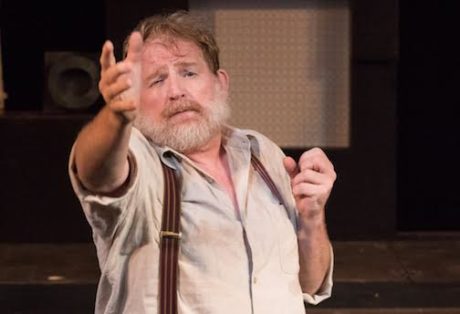Like a gift that keeps on giving, Shakespeare’s A Midsummer Night’s Dream keeps on rekindling. Dreamer after dreamer reconceives it as if anew. And last night that classic spark reignited at Gallaudet University, where the Theater and Dance Program presented a production to be delighted by—whether this be your first Dream or umpteenth.

“It is sweet comedy,” Bottom reminds his fellow Pyramus-and-Thisbeans. The same must be said of Director and Scenic Designer Ethan Sinnott’s staging, although it is, in a very funny way, pitch dark as night.
The set, for starters, is a stark all-black abstraction with a cascade of askew stairs, irregular shapes and odd angles, and cutouts and floor vents through which Lighting Designer Annie Wiegand has light peeking in as if from stars in the sky or some netherworld. No royal palace or enchanted woodland this, it is a macabre magic box. Branches of birch stripped of foliage are stuck in holes about the floor to indicate forest, but that’s as lush as it gets. The sense we are in some underworld rather than fairyland is underscored when we meet the fairies.
And by gosh they look like riffraff punks or downtown goth kids dressed all in black leather with studs and chains. Oh and they also wear menacing facepaint. (Costume Designer Stephanie Fisher does the thug garb; Makeup Artist Nikolya Sereda, the masked faces.) The distance between one’s preconception of airy spirit sprites and this merry band of marauders remains a hilarious cognitive dissonance throughout the show
The effect is made all the more fun by the actors, who play it to the hilt. The role of Puck is performed by the luminous Miranda Medugno (Puck Prime) along with Jane Enabore (Puck 2) and Paige Hawkins (Puck 3). Together they make one badass trio.
Oberon looks more Hells Angels than fairyville, and Andrew Morrill’s performance of him as a scary heavy is topped off by two foot-high hair spikes on his head. Titania is drama queen of the night in the captivating Chelsea Hilaire’s lusty incarnation. And assorted other fairies appear as ubercool hooligans: Fairy (Yader Martinez), Moth (Tyresha Collins), Peaseblossom (Krystle Stewart), Cobweb (Caldonia Wilding), and Mustardseed (Emily Catalfamo).
Visiting Professor Howie Seago brings to the role of Bottom a seasoned comic gift along with gravitas, and he anchors well the ridiculous ragtag bunch of Quince (Ryan Barrett), Flute (Brandon Holst), Snout (Chukwudi Kalu), Starveling (Dae-Kun Kim), and Snug (Nate Eubanks).

In a nice touch, Sinnott has the fairies meddle in scenes even when they’re written to be offstage, including when the Rude Mechanicals are prepping their preposterous playlet. We see the would-be actors wander amusingly across stage now and then, their scripts in hand, trying to learn their lines. And in a really silly running sight gag, they sometimes seem to step in shit.
This production is packed as full of sight-gag delights as a piñata. Much of the pleasure stems from the hilariously hyper-expressive physical comedy in the acting style that animates the Bard’s poetry into ASL. The result is that the actors literally transcend the text by adding a whole other dimension of humor. I don’t know sign so I couldn’t catch what they were up to, but I suspect it was a lot. One instance I recognized cracked me up: When Bottom says, “I am a man as other men are,” another actor’s cupped hands appear below his crotch to indicate cajones.
Sumit Malik as Theseus and Stephanie Kesterke as Hippolyta make a suave and sophisticated couple, and leave no doubt there’s a liplocked fire in their loins. Farhan Rana is unhinged with rage as Egeus, and Britton Auman and Duvi Silva as Philostrate 1 and 2 play twin factotums with aplomb.

The knockabout antics of the four lovers become an ongoing entertainment all their own: William Millios as Demetrius, Aylah Cadwell as Hermia, Casey Johnson-Pasqua as Helena, and the magnetic Gideon Firl as a James Dean–like Lysander. No one is credited as fight and tumbling choreographer (or mating-dance captain), but someone amazing put these actors through the paces that became breathtaking stunts.
For hearing audiences, voice actors Mary Beth Morgan, David Walsh, Carol Spring, TD Smith, Grant Chism provide simultaneous interpretation. (There is also a sound design by Robert Pike that, I have been informed, was not playing back correctly last night.)
Gallaudet University is the DC host site for “First Folio! The Book that Gave Us Shakespeare,” a national traveling exhibition sponsored by the Folger Shakespeare Library, The American Library Association, and the Cincinnati Museum Center. It will be on display at Gallaudet through October 31, 2016, and this production of A Midsummer Night’s Dream is part of it.
I can’t help thinking Shakespeare would be tickled to see his words so alive in motion.
Running Time: Two hours 40 minutes, including one intermission.
A Midsummer Night’s Dream presented by the Gallaudet University Theatre and Dance Program plays through November 6, 2016 at the Eastman Studio Theatre in the Elstad Annex of Gallaudet University – 800 Florida Avenue. NE, in Washington, DC. All performances are signed and voice interpreted except Sunday, October 23, 2 pm; Thursday, October 27, 8 pm; and Saturday, November 5, 2 pm, which are signed only. For tickets, purchase them online.





